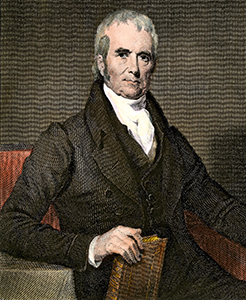MARBURY TO BROWN:
Judicial Review from Early Republic to Postwar America
Introduction
By examining two landmark Supreme Court cases, Marbury v. Madison and Brown v. Board of Education, students will explore the significance of Judicial Review as a check to balance the three branches of the United States government.
Standards
Virginia
- VUS.5: The student will apply social science skills to understand the development of the American political system by
- b) describing the major compromises necessary to produce the Constitution of the United States, with emphasis on the roles of James Madison and George Washington
- VUS.13: The student will apply social science skills to understand the social, political, and cultural movements and changes in the United States during the second half of the twentieth century by
- b) evaluating and explaining the impact of the Brown v. Board of Education decision, the roles of Thurgood Marshall and Oliver W. Hill, Sr., and how Virginia responded to the decision;
National
- NSS-USH.5-12.3 Era 3: Revolution And The New Nation (1754-1820s)
- NSS-USH.5-12.9 Era 9: Postwar United States (1945 to early 1970s)
- D2.Civ.1.9-12: Distinguish the powers and responsibilities of local, state, tribal, national, and international civic and political institutions.
- D2.Civ.4.9-12: Explain how the U.S. Constitution establishes a system of government that has powers, responsibilities, and limits that have changed over time and that are still contested.
Key Hook/Question
How does the principle of Judicial Review allow the Judiciary to act as a check on the Legislative and Executive branches of government?
Downloads
The slideshow below can be used in this browser-based format, or downloaded as a presentation or PDF outline. You may also use the button below to make a Google Slides copy in order to adapt or edit the presentation.





